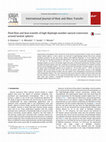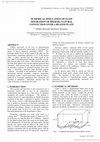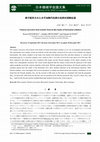Papers by Akihiko MITSUISHI
Ryutai Kogaku Bumon Koenkai koen ronbunshu, 2022
Ryutai Kogaku Bumon Koenkai koen ronbunshu, 2022
Advanced Experimental Mechanics, 2020
Advanced Experimental Mechanics, Aug 10, 2018

International Journal of Heat and Mass Transfer, Jul 1, 2015
Experimental investigations were carried out on the natural convective flows of water and air ind... more Experimental investigations were carried out on the natural convective flows of water and air induced around heated spheres. A keen interest was directed to high-Rayleigh-number flows that undergo turbulent transition. For the sake of this, spheres with different diameters, d = 50 to 1000 mm, were fabricated and tested, and this enabled the experiments in the wide and high ranges of Rayleigh numbers, 5 Â 10 6 < Ra d < 4 Â 10 10 for water and 4 Â 10 5 < Ra d < 4 Â 10 9 for air. In particular, the present maximum Rayleigh numbers are one or two decades higher than those of the prior experiments. The flows ascending along the heated spheres were first visualized to investigate the mechanisms of turbulent transition and the critical Rayleigh numbers. The results showed that the turbulent transition begins at the top of the sphere when the Rayleigh numbers are at around 3.0 Â 10 8 for water and 3.5 Â 10 8 for air. Then, the transition points move from the top to the side of the sphere with further increase in the Rayleigh numbers. The average Nusselt numbers from the spheres were subsequently measured and correlated with the Rayleigh numbers. The result showed that the present Nusselt numbers coincide fairly well with the prior laminar correlations in the range of the Rayleigh numbers less than the above critical. On the other hand, they showed a considerable deviation from the prior turbulent correlation when the Rayleigh numbers beyond the critical.
Proceedings of the ... ASME/JSME Thermal Engineering Joint Conference, 2003
The Proceedings of the Fluids engineering conference
The Proceedings of the Fluids engineering conference

IOP Conference Series: Materials Science and Engineering, 2020
The interfacial behaviour of a liquid droplet placed on an oscillating plate was simulated numeri... more The interfacial behaviour of a liquid droplet placed on an oscillating plate was simulated numerically by VOF method for the better understanding of the transition process of the surface fluctuation from the axisymmetric mode to the complicated mode which is leading to the interface burst and spray formation. The target of analysis was a water droplet of 100μL placed on a flat plate. In the place of the plate oscillation, a sinusoidal acceleration-oscillation was applied with the gravitational acceleration. The frequency of the acceleration-oscillation was ranging from 300 Hz to 900 Hz. The range of the acceleration-oscillation amplitude was from 3g to 60g. The computational domain was set to include a quarter of the droplet. In the numerical simulation, axisymmetric concentric waves and superposed azimuthal waves appeared on the droplet surface. The surface fluctuation grew in magnitude with an increase in the acceleration-oscillation amplitude, and the complexity of the interface ...

Proceedings of the International Conference on Jets, Wakes and Separated Flows, ICJWSF, 2013
Natural convection of air over an upward-facing horizontal two-dimensional heated plate is invest... more Natural convection of air over an upward-facing horizontal two-dimensional heated plate is investigated by means of direct numerical simulation (DNS). The Rayleigh number based on the length of the plate and the representative temperature difference is 10 8 in the present study. A plume uprising from the central region of the plate induces two-dimensional boundary layer flow over the plate from its edge to the center. This boundary layer flow develops from laminar state with the ambient quiescent fluid entrained. In the present study, special attention is focused on turbulence structure of separated boundary layer flow under a practically important high Rayleigh number condition. According to the preliminary study of threedimensional thermal instability, spanwise temperature disturbance within a narrow band region along the edge is employed to encourage spontaneous flow separation and transition to turbulence. Turbulence structure near the center of the plate is statistically discussed.
The Proceedings of the Fluids engineering conference
Journal of the Japanese Society for Experimental Mechanics, 2015

Volume 1: Fluid Mechanics
The influence of the traveling wave control on flow fields is evaluated by experiments using a tr... more The influence of the traveling wave control on flow fields is evaluated by experiments using a traveling wavy wall in a fully developed turbulent dual channel flow. We develop a traveling wave generator using a rubber sheet and piezoelectric actuator as a vibration source. A single piezoelectric actuator is installed in the upstream position of the channel. Experiments are performed using traveling waves attenuating in the downstream direction. With traveling wave control, effective drag reduction is confirmed when bulk Reynolds number is within the range of 2000 < Reb < 6000. For Reb = 3000, the maximum drag reduction rate of 10% is obtained. In order to evaluate a relationship between the amplitude attenuation of traveling wave and drag reduction effect, particle image velocimetry (PIV) at multiple positions is performed. Increase of drag is observed near the vibration source whereas drag decreased at other positions. Reduction of random component of Reynolds shear stress ca...

Journal of the Japanese Society for Experimental Mechanics, 2014
Injecting liquid downward into the stationary atmosphere from an oblong-orifice of 0.15mm x 1.3mm... more Injecting liquid downward into the stationary atmosphere from an oblong-orifice of 0.15mm x 1.3mm, the breakup behavior of the liquid jet was observed in detail by flash photography. Test liquids employed were water, ethanol and aqua-solutions of propylene-glycol. Liquid injection velocity was ranging from 1 to 20 m/s. It was found that the liquid jet deformed into chains of bamboo-leaf-like liquid films, the edges of the liquid film became thick rims due to the surface contraction, the threaded-beads-like wave of short wavelength appeared on the rims, and the liquid jet broke up regularly due to the wave. The resulting droplets were more uniform and smaller than those of liquid jet from circular-orifice. Satellite droplets were also formed, but the generating frequency was not so high. The characteristics of interfacial wave on liquid jet and the size distribution of droplets were investigated by image analysis. Based on the results, the mechanism of regular breakup of the liquid jet from oblong-orifice was discussed. The effects of liquid properties upon the suitable velocity range for regular breakup were also examined. It was supported that the regular breakup of liquid jet should be of use as a simple methodology for uniform-sized droplet production.

Transactions of the JSME (in Japanese), 2018
The natural convective heat transfer from banks of heated horizontal cylinders to air was investi... more The natural convective heat transfer from banks of heated horizontal cylinders to air was investigated experimentally. The experiments were mainly carried out with the in-line tube banks consisted of five stairs of ten-cylinder-row aligned horizontally. The whole cylinders in the bank were heated with identical heat flux and their diameter d, vertical and horizontal gaps G h , G v between cylinders were varied as d=8.4, 14.4 mm, G h =10.6-30.6 mm and G v =5.6-30.6 mm. The flows induced in the banks were first visualized with smoke and the Nusselt numbers of the whole cylinders in the banks were subsequently measured. The visual results depicted that the smokes issued from the upstream of the bank gather gradually toward the vertical centerline of the bank. With the gathering of the plumes, the Nusselt numbers of the cylinders placed near the center of the horizontal rows show marked reduction in the downstream direction. Their Nusselt numbers were rearranged with several parameters to obtain non-dimensional heat transfer correlations. It was found that the Nusselt numbers Nu Gv for the second to fifth stairs in the bank are correlated well with the parameter [Ra Gv * (G v /d)(G h /d)], while those for the first stair are predicted well with the parameter [Ra Gv * (G v /d) 2 ], where Nu Gv and Ra Gv * stand for the Nusselt and the modified Rayleigh numbers based on the vertical gaps G v .

Volume 1: Fluid Mechanics, 2019
It has been widely expected that the pulsating control can reduce friction drag in various fluid ... more It has been widely expected that the pulsating control can reduce friction drag in various fluid systems. In order to maximize its effect, a prediction tool of drag reduction using pulsating control is required. The present study aims at the prediction of the drag reduction rate by machine learning. Multilayer perceptron (MLP) was applied as the machine learning method. Water was used as the working fluid. First, an automatic measurement system was constructed and drag reduction effect was evaluated by an experiment with various pulsation waveforms. The flow pulsation was generated by giving periodical acceleration and deceleration by a centrifugal pump in a closed circulation system. The bulk Reynolds number Reb ranges between 3400 and 3800. Next, the experiments were performed with over 5000 kinds of waveforms to make training and validation data for MLP. Within the data, the maximum drag reduction rate of 38.6% was observed. The friction coefficient Cf decreased during the accele...

Heat Transfer Research, 2009
Natural convective flows around an array of vertical heated plates were investigated experimental... more Natural convective flows around an array of vertical heated plates were investigated experimentally. Main concerns were directed to the influences of plate numbers on the heat transfer characteristics of the plates. Both surfaces of the test plates were heated with constant and equal heat fluxes and their local heat transfer coefficients were measured. The results showed that the coefficients of the surfaces of the array facing outward became higher than those facing inward. The flow fields around the bottom of the plate array were visualized with smoke. The result showed that the ambient flow is directed from the sides to the center of the array and enters the parallel channel obliquely. These flows cause the above difference in the coefficients. While the difference gradually diminished in between the plates placed in the central section of the array, their coefficients asymptotically approach those of the analytical correlation that assumed a uniform velocity at the channel inlet...









Uploads
Papers by Akihiko MITSUISHI